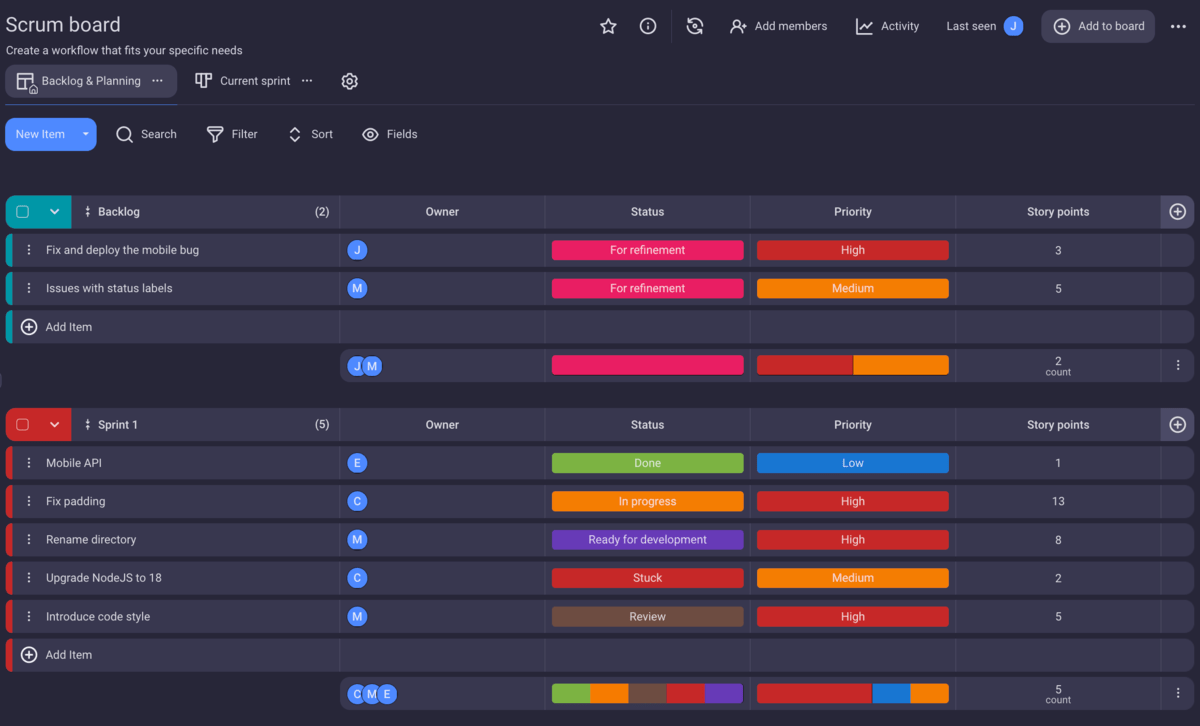The Scrum Roles and Responsibilities: Explained
Building a Scrum Team is the first step toward implementing the Scrum framework within an organization. Therefore, it’s crucial to understand Scrum Roles and each of their responsibilities.
As Scrum roles differ from the usual project roles, we’ve prepared a guide to walk you through all the specifics.
We’ve also included some interesting expert insights and several useful tips on how to build a successful Scrum Team.
So, let’s dive in!

- The 3 main roles within the Scrum Team are Product Owner, Scrum Master, and Developers.
- The Product Owner works on maximizing the product value and also manages the Product Backlog.
- The Scrum Master leads and guides the entire Scrum Team, as well as teaches and facilitates the implementation of Scrum.
- Developers are those who develop and create usable Product Increments each Sprint.
- Scrum Master focuses on the team, while the project manager focuses on the project itself.
- Building a Scrum Team is a process that aims to foster a sense of unity and self-management within the team by devoting enough time to growth, investing in team-building, coming up with a team name, and embracing Sprint Retrospectives.
Table of Contents
What are Scrum Roles? (+ their responsibilities)
The 3 main roles in a Scrum Team are Product Owner, Scrum Master, and Developers.
Scrum roles exist to provide clarity of responsibilities within the Scrum Team.
According to The Scrum Guide, the Scrum Team is a small team of typically 10 or fewer people, who all work together toward a common objective — the Product Goal.
To improve focus and efficiency and ensure continuous improvement, the Scrum Team works in Sprints. With every Sprint, the Team is accountable for creating a valuable Increment (a concrete step toward the Product Goal).
The Scrum Team is responsible for all product-related tasks, such as:
- Collaboration with project stakeholders,
- Maintenance,
- Operation,
- Experimentation,
- Research and Development, and much more.
Now, let’s describe each role’s specific responsibilities in more detail.
Role #1: Product Owner — maximizing the product value
The Product Owner is responsible for maximizing the product value, as well as effective Product Backlog management.
Here are some of the usual responsibilities of a Product Owner:
- Sets and expresses the Product Goal,
- Creates and communicates the Product Backlog items to the team,
- Orders the Product Backlog items,
- Transfers the Product Backlog items to the Sprint Backlog, and
- Makes sure that the Product Backlog is visible, transparent, and understood.
Here’s how our contributor, Dr. Todd A. Jacobs, CISM CISSP MBA PhD, Chief Information Technology Officer at CodeGnome Consulting, describes the role of a Product Owner:

“Without resorting to Scrum Guide definitions, the Product Owner is the product’s champion and visionary. The role works in collaboration with customers, organizational stakeholders, and other members of the Scrum Team to define what the product can or should do.
The Product Owner then communicates that vision as a set of prioritized Product Goals to everyone involved, setting stakeholder expectations and enabling the Developers to deliver goal-focused units of work on a reliable cadence. By setting the project’s priorities, the Product Owner also indirectly manages the project’s budget by defining Product Goals that deliver measurable stakeholder value at predictable intervals.”
💡 Plaky Pro Tip
A Product Owner’s role is often confused with the role of a project manager. Check out the following guide to learn how these 2 roles differ:
Role #2: Scrum Master — leading and coaching the team
A Scrum Master is a leader who guides the entire Scrum Team and facilitates the implementation of the Scrum framework.
Instead of focusing on the project or product itself, Scrum Master helps everyone within an organization understand Scrum theory and practice.
The Scrum Master plays a triple role, as they serve:
- The Scrum Team,
- The Product Owner, and
- The Organization.
The Scrum Master’s responsibilities include:
- Assisting the Product Owner during Sprint Planning and Sprint Reviews to ensure the direction is clearly set,
- Coaching team members in self-management,
- Teaching team members cross-functionality,
- Helping team members focus on the creation of valuable Increments,
- Assisting team members in meeting the Definition of Done (the agreed-on quality measures),
- Removing any obstacles that hinder the team’s progress,
- Making sure that the team understands the need to define clear Product Backlog items,
- Helping establish empirical product planning for a complex environment,
- Leading the organization in its Scrum adoption,
- Removing barriers between stakeholders and Scrum Teams, and much more.
Dr. Todd A. Jacobs adds that the best Scrum Masters have several traits in common:

“While there are a number of ‘accountabilities’ defined in the official Scrum Guide, the best Scrum Masters are really team coaches and process referees. They help organizations new to Scrum make the most of the framework, and call fouls when members of the team or the organization break the fundamental working agreements that make the Scrum framework so effective.”
Role #3: Developers — delivering releasable increments of work
Developers are the members of a Scrum Team who create usable Product Increments each Sprint.
The term Developers refers to the individuals who develop and create the Increment, regardless of the domain of work.
Several typical responsibilities of the development team members include:
- Planning the Sprint,
- Creating the Sprint Backlog,
- Adjusting the daily plan through Daily Scrum meetings to meet the Sprint Goal,
- Ensuring quality by sticking to the Definition of Done, and
- Holding other Developers accountable as professionals.
Here’s how Dr. Todd A. Jacobs explains the Developers’ role in a Scrum Team:

“Scrum can be used in other contexts, but it’s most often used for some form of product development. Regardless of the type of product, anyone who isn’t the Scrum Master or the Product Owner is a ‘Developer.’ Collectively, the Developers are accountable for determining how to deliver incremental units of work that advance the team towards the current Product Goal.”
💡Plaky Pro Tip
To learn the difference between the Sprint Backlog and Product Backlog, check out the following posts:
Scrum Master vs project manager
As the Scrum Master’s role often coincides with that of a project manager, we’ve turned to experts to help explain the difference.
Here’s how Abhay Talreja, a Senior Consultant at Deloitte, an Agile guru, and a Certified Scrum Master, describes the Scrum Master’s role:

“A Scrum Master helps remove obstacles that could hinder the team’s progress by coaching the team on Scrum practices. The Scrum Master also ensures that the team is self-organizing, facilitates Scrum events, and helps protect the team from outside interference and pressures.”
On the other hand, as Abhay explains, a project manager has a more direct role in a team’s day-to-day work:

“The project manager is responsible for the planning, execution, and completion of the project. They are responsible for managing the resources, tracking progress, and making adjustments and are generally a single point of accountability for the success or failure of a project. As opposed to Scrum, where [success or failure] is the responsibility of the Development team.”
According to Christina Lukynyuk, a Certified Scrum Master and Project Manager at Softjourn, inc., there’s one thing in particular that differentiates a Scrum Master from a project manager:

“One of the most contrasting differences [between a project manager and a Scrum Master] is the Scrum Master’s role in team development and allowing for the self-sufficiency of the team. What I mean by this is that, when a team has been taught to become self-sufficient on a project and manage the Scrum principles by themselves, that’s when the Scrum Master can leave. When a team takes responsibility for a project, that is the true testament to a job well done by a Scrum Master.
This is different from a project manager, as they will usually stay on a team for the duration of the project.”
How to build a Scrum Team
Building a Scrum Team involves much more than just putting people together and expecting them to be a team.
On the contrary, this should be a carefully thought-out process that aims at fostering a sense of unity and self-management.
To clarify what exactly this entails, we’ve prepared a few useful tips that should help you build a Scrum Team that actually works well together.
So, keep reading!
Tip #1: Give time for growth
As explained in the article by Christiaan Verwijs, How To Kickstart A Great Scrum Team (10 practical things to do), there are several phases all teams need to go through until they arrive at the phase when they constructively and independently work together to create value.
To reach the so-called performing phase, where the team feels safe and has no fear of making mistakes, a certain time needs to pass.
How much time it’ll take differs from team to team. So, don’t rush anywhere. It may take a few Sprints until the Scrum Team members become more flexible in their roles.
And it’s the Scrum Master’s responsibility to guide and advise the team until they’ve reached that point.
Tip #2: Invest in team-building activities
We’ve already mentioned that one of the Scrum Master’s responsibilities is to teach the Scrum Team self-management.
This means that the team members should arrive at the point where they autonomously organize and control their work, as well as become capable of solving problems on their own.
However, for this to happen, the key is to form a collaborative team environment first.
And what’s a better way to do this than by investing time in team-building activities?
Team-building activities are a great way to break the ice, help team members get to know each other, and step out of their comfort zone.
💡Plaky Pro Tip
To find more tips on how to improve project team collaboration and why it is important, check out the following blog post:
Tip #3: Come up with a team name
An excellent way to build a sense of community is to ask the team to come up with a team name.
Having a unique team name is not only fun but also a powerful way to better connect the team members.
As explained in the previously-mentioned article by Verwijs, people will more easily associate themselves with the group if you give them something small, such as a team name, to identify with.
Tip #4: Embrace Sprint Retrospectives
Sprint Retrospectives are the most important Scrum Events, as they are a perfect opportunity for Scrum Team members to grow.
So, make sure not to skip them.
Also, be well-prepared for the Retrospectives and always experiment with different approaches, as this helps teams reflect on themselves and their processes from a different perspective each time.
The main goal is that the team members develop the ability to come up with solutions themselves, and the Scrum Master should be there only to assist them.
📖 Now that you know what Scrum roles and responsibilities are, dive further into the topic of project management — Check out our Project Management Glossary of Terms and get acquainted with project management terminology.
How Plaky helps the Scrum Team perform better in their roles
In conclusion, while each Scrum Role has its distinctive responsibilities, their effective collaboration significantly influences the overall performance of the Scrum Team.
So, our advice is to analyze each Role independently but focus on making them all work as one.
Here’s a tip regarding the Scrum Team efficiency offered by Dr. Todd A. Jacobs:

“Scrum Teams work best when they function as a unit rather than as a collection of individuals. That makes communication, a sense of collective ownership, and a willingness to view units of work as “ours” rather than as “mine” or “yours” essential to success. In addition, Scrum Teams work best when they are allowed to become a real team that knows how to work together on related projects. Pulling together a new set of individuals for each project is a common anti-pattern that results in high process overhead early in the project. The most frequent consequences of that are cost overruns and missed target dates that more mature Scrum Teams can often avoid.”

Using the Plaky project management tool can help each of the Scrum Team members perform in their roles better. Product Owners can manage the Product Backlog in Plaky, while Developers may organize and plan Sprints.
In addition, using Plaky will help the team learn to function as a cohesive unit while making the Scrum process transparent and organized properly.
To start managing your Scrum process with the Plaky project management tool — sign up for Plaky’s free account and try it today.
References
- Schwaber, K., & Sutherland, J. (2020). The Scrum Guide. https://scrumguides.org/docs/scrumguide/v2020/2020-Scrum-Guide-US.pdf#zoom=100
- Verwijs, C. (2020, October 15). How to kickstart a great scrum team (10 practical things to do). Medium. https://medium.com/the-liberators/how-to-kickstart-a-great-scrum-team-10-practical-things-to-do-2143bdde1a8d
 Project Management Hub
Project Management Hub 











